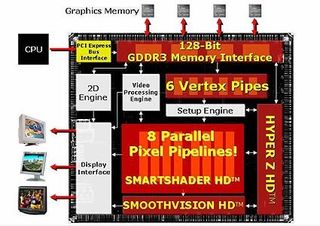ATi Hits Back (Again) with Mid-Range X700 line, Driver Tweak
The ATi Radeon X700 Series
Based on the X800's architecture, the new processor, code-named RV410, is to succeed the X600 PCI Express component that was based on the Radeon 9600 AGP processor. The X700's direct competitor, then, is NVIDIA's newly launched GeForce 6600 mid-range line of cards (NVIDIA GeForce 6600 GT Comes To THG's Lab) .
Like NVIDIA, ATi was very careful in its paring-down of this processor. The number of pixel pipelines was reduced to eight and the memory interface was halved to 128bit. Like its bigger siblings in the X800 family, the X700 sports a full complement of six vertex pipelines, resulting in excellent polygon throughput and, at least on paper, granting this processor quite an advantage over the GeForce 6600, since NVIDIA was also forced to reduce the number of vertex pipelines in the GeForce 6600 to lower the transistor count.

A block diagram of the X700 - 8 pixel pipelines, 6 vertex shaders and all of the features of the X800.
The end result is a processor that, weighing in at 110 million transistors, is much more compact than NVIDIA's NV43, which offers more than 146 million transistors. This shouldn't really be surprising, however, considering that ATi still only supports DirectX 9.0b with this processor, meaning "only" 24bit floating-point precision and a maximum of Shader Model 2.0b. NVIDIA's processors, on the other hand, already support DirectX 9.0c, Shader Model 3.0 and 32 bit floating point precision - which is why they require more transistors.
The feature list of the X700 is equivalent to that of the X800: 3Dc, SmoothVision HD, SmartShader HD, VideoShader HD and HyperZ HD. You can read up on these technologies in our previous article here (ATi's X800 Pulls Off Another Coup in the Graphics Performance War) .
Upon its introduction, the X700 will only be available in PCI Express versions. Currently, three different models of the processor are planned, corresponding to ATi's established nomenclature: X700, X700 Pro and X700 XT. These will differ in the amount of memory with which they come equipped as well as their core frequencies.
Stay on the Cutting Edge
Join the experts who read Tom's Hardware for the inside track on enthusiast PC tech news — and have for over 25 years. We'll send breaking news and in-depth reviews of CPUs, GPUs, AI, maker hardware and more straight to your inbox.
Current page: The ATi Radeon X700 Series
Prev Page ATi X700 - Bringing X To The Mid-range Next Page Radeon X700 XTMost Popular

